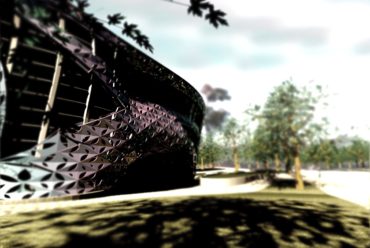Back to the Future
THE 3DS MAX BLOG
Back to the Future
By Eddie Perlberg – Oct 29, 2015 – 3ds Max – Games, Design Visualization
Hey everyone, Tom Hudson here.
October 31st, 2015 marks 3ds Max’s 25th aniversary. To mark the occasion, I thought it would be fun to go back and look at where we’ve been on the journey to make 3ds Max what it is today – a lot of things have changed, and some have not.
In The Beginning…
For me, like a lot of people in the computer graphics world, when the film TRON came out in 1982, it was an eye-opening experience that was incredibly inspiring. The film isn’t a masterpiece on the level of Dr. Zhivago, but its ground-breaking use of 3D computer graphics got a lot of us thinking – I wanted to create cool graphics like the ones in that film!
Sark’s carrier (TRON)
At the time, I was working with Atari 8-bit computers at ANALOG Computing Magazine, and those systems were a far cry from what they used to create TRON! But the dream to replicate those images was there, and we did what we could to keep it moving, using whatever means we had. If you look at my desk back in that time period, you’ll see a mess of diskettes, printouts and books (notably, Newman & Sproull’s “Principles of Interactive Computer Graphics”, the bible for CG work at the time) – And above the desk is a calendar.
My ANALOG office & The Calendar
The calendar in this photo is full of early CG images – rudimentary Gouraud-shaded graphics, very primitive by today’s standards – but incredibly inspirational back then!
My goal was to be able to duplicate those kinds of images and ultimately create animations and tell stories. Using the Atari’s basic graphics capabilities, I started working on various projects that would hopefully get me where I wanted to be.
The great-grandfather of 3ds Max is a little program called “Solid States” – created for the Atari 8-bit machines and written in BASIC, it allowed you to create and render wireframe representations of objects. By creating a list of viewpoints and targets, you could actually animate a flyby of something like a spaceship – The first thing I modeled in it was a representation of a model I had scratchbuilt several years earlier. Not Sark’s carrier from TRON, by any stretch of the imagination, but it was a step in the right direction!
Physical model
Solid States version
As additional output devices such as Atari’s Model 1020 pen plotter came out, we enhanced the software to use them to produce better output, and used those to create cover photos for the magazine. It was a blast.
In early 1985, Atari introduced the ST, a Motorola 68000-based computer that I couldn’t wait to get my hands on – it had much better graphics capabilities than the 8-bit systems we had been using – higher resolution, more colors, more speed; it was the next step in getting where I wanted to be. Fate then stepped in and I met Gary Yost, who wanted to market software for the ST – I told him I had an idea for a 3D modeling package…
With Gary, Solid States evolved into a much more advanced 3D modeling package called CAD-3D (May, 1986). It had far better modeling capabilities using mouse input, better rendering than the 8-bit systems because the ST could display a whopping 16 colors, and had several fairly powerful tools for the time.
CAD-3D Models
As we moved forward, our team added Mark Kimball, who developed an animation playback system that was the forerunner of tools like Quicktime. We added stereo 3D output, faked texture mapping and more – but the 16-color limit was a problem that was starting to become a real hindrance to our goal of producing more-realistic output: you just couldn’t get high-quality shading. And despite its more powerful processor, the ST would slow to a crawl when performing the calculations necessary to do high-quality shading.
The solution to these issues was to move to the IBM PC – At this point, the 80386 processor was just becoming available. Its companion math coprocessor chip, the 80387, would make these calculations much faster. But the real lure for me was the fact that the PC had a truecolor graphics card available – the ATVista. It would make our dreams of realistic renderings possible. For the user interface, we’d use the then-new VGA graphics cards, which would allow 256 colors onscreen at ONE TIME. Wow!
This is where we joined forces with Autodesk to create the original 3D Studio for DOS. And it was no longer a one-programmer setup: Dan Silva, who had written Deluxe Paint for the Amiga, joined us to write the Keyframer module.
3ds DOS
The early days of 3ds were pretty simple, really. There was one VGA standard, so I wrote one set of graphics driver code. We supported the ATVista and a couple of other cards for truecolor output, so that was pretty simple. There were no multi-processor systems, so we didn’t have to worry about multi-threaded code. There were only two programmers, so managing our code wasn’t too complex. Gary managed the project and Jack Powell handled documentation and helped keep things consistent in the program user interface.
Despite having relatively fast computers, we still had to be careful about performance. I wrote the original renderer and was always trying to find cheats to make it faster – but those always cost something in terms of quality. Still, the dream of creating my version of TRON was starting to come true. Every day after work, I’d sit down with the software and create something with it. One of the first was created by doing a frame grab from my camcorder using one of our truecolor display adapters and rendering a hovercraft model:
A hovercraft in my back yard!
This had me grinning from ear to ear. Looks pretty awful today, but it was better than 16 colors on an Atari ST!
The first version of 3ds DOS was released at the end of October, 1990. As part of the rollout, a team at Autodesk created “The Bored Room”
and I created “Corner Stone”
Simple videos, but we were actually doing what we had dreamed about just a few years earlier.
This early software had no Undo/Redo capability, you could only animate certain things and there were no procedural models (once you built something, if you wanted to change its basic attributes you had to go back and re-create it). System memory was very limited. Looking back, it was awfully primitive.
As we moved forward, the two-programmer team just wasn’t adequate for developing new tools, so we added a plug-in interface for expansion. Networking was becoming affordable, so 3ds got networked rendering capabilities.
In 1994, the Yost Group expanded its development team again, adding Don Brittain and Rolf Berteig for the push to create 3ds Max.
Yost Group, 1994. (L-R) Don Brittain, Tom Hudson, Rolf Berteig, Gary Yost, Jack Powell, Dan Silva
The larger team meant having to set up more complex source code control, but it was still very small compared to today’s 3ds Max development team!
Over the years since we started developing 3ds Max, a lot has changed. Back then:
– 1 Processor
– Basic VGA graphics, no GPUs
– Very limited and expensive memory
– Limited tools, slow Internet made collaboration difficult
– Small team; we could only do so much
Now, computers have lots of cores, virtually unlimited memory and an amazing variety of display adapters with GPU acceleration. Networking and Cloud functionality has opened up incredible possibilities for collaboration. And the Max team is huge, distributed all over the world – this includes the third-party plugin developers, who do simply amazing things.
What hasn’t changed?
I was thinking about this recently when looking at Autodesk’s motto – Imagine, Design, Create. It fits perfectly with what Max is at its core, and why it was created in the first place.
The original dream behind 3ds Max was the goal of being able to create just about any kinds of graphics or animation you want – from abstract to cartoony to realistic. To take your inspiration, whether it’s an image from TRON, a concept for a skyscraper or anything else and turn it into reality.
Some things change; some things never do.
P.S. My desk is still a mess.
—–
A full writeup on the Atari roots of 3ds Max can be found at: http://doudoroff.com/atari/
ARTICLE BY
Eddie Perlberg

















